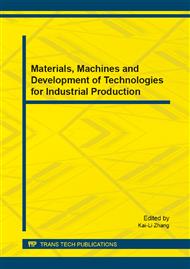[1]
Arapogianni Athanasia, Genachte Anne-Benedicte, Moccia Jacpoa. The offshore wind market deployment: forecasts for 2020, 2030 and impacts on the European supply chain development, Energy Prodia. 24(2012) 2-10.
DOI: 10.1016/j.egypro.2012.06.080
Google Scholar
[2]
Mark JK, Brian FS. Modeling offshore wind installation costs on the U.S. Outer Continental Shelf, Renewable Energy, (2013) 50, 676-691.
DOI: 10.1016/j.renene.2012.07.042
Google Scholar
[3]
Tong KC. Technical and economic aspects of a floating offshore wind farm, Journal of Wind Engineering and Industrial Aerodynamics, 74 (1998), 399-410.
DOI: 10.1016/s0167-6105(98)00036-1
Google Scholar
[4]
Pedro SV, António JNAS, Marco A. Offshore wind farm layout optimization—state of the art, Journal of Ocean and Wind Energy, (2014) 1, 23–29.
Google Scholar
[5]
Simon Lefebvre, Maurizio Collu. Preliminary design of a floating support structure for 5MW offshore wind turbine. Ocean Engineering. 40(2012) 15-26.
DOI: 10.1016/j.oceaneng.2011.12.009
Google Scholar
[6]
Information on en. wikipedia. org/wiki/Floating_wind_turbine#Economics.
Google Scholar
[7]
Latha Sethuraman, Vengatesan Venugopal. Hydrodynamic response of a stepped-spar floating wind turbine: Numerical modeling and tank testing. Renewable Energy. 52(2013) 160-174.
DOI: 10.1016/j.renene.2012.09.063
Google Scholar
[8]
Y.H. Bae M.H. Kim. Rotor-floater-tether coupled dynamic including second-order sum -frequency wave loads for a mono-column-TLP-type FOWT(floating offshore wind turbine). Ocean Engineering. 61(2013) 109-122.
DOI: 10.1016/j.oceaneng.2013.01.010
Google Scholar
[9]
Evan Michael Harriger. Dynamic analysis of a 5 Megawatt offshore floating wind turbine. Mater thesis. University of California, San Diego. (2011).
Google Scholar
[10]
Behzadian M, Otaghsara SK, Yazdani M, et al. A state-of the-art survey of TOPSIS applications, Expert Systems with Applications, (2012) 39, 13051-13069.
DOI: 10.1016/j.eswa.2012.05.056
Google Scholar
[11]
Mingues EL, Kolios AJ, Brennan FP. Multi-criteria assessment of offshore wind turbines support structures, Renewable Energy, (2011) 36, 2831-2837.
DOI: 10.1016/j.renene.2011.04.020
Google Scholar
[12]
Jonkman J., Butterfield S., Musial W., Scott G. Definition of a 5-MW Reference Wind Turbine for Offshore System Development Technical Report. NREL/TP-500 -38060 . February (2009).
DOI: 10.2172/947422
Google Scholar
[13]
Ge LL, Qe Y, Zhang ZX, et al. The calculation of the extreme wind, wave and current for return periods in the deep water area of South China Sea, China Offshore Oil and Gas, (2009) 21, 207-210.
Google Scholar


